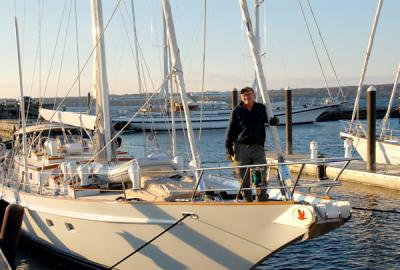Passage by Sail From Rhode Island to Tahiti

The following, by Capt. Ed Gifford, a licensed sea captain of East Hampton, whose “Glory of Sail” photos of classic ocean racing yachts can be seen at the Bruce Tait and Associates office on Bay Street in Sag Harbor, is an account of the first leg of his voyage aboard the sloop Coro Coro from Portsmouth, R.I., to Tahiti.
In June, a shipmate friend of over 25 years, James Johnson, of Aspen, Colo., asked me to check out a boat he had been keeping his eye on, a 74-foot Royal Huisman Shipyard sloop, for a possible passage to Tahiti.
So, on his behalf, I visited the shed at the Hinckley Yacht Yard in Portsmouth, R.I., where I found Coro Coro [its name deriving from the Scarlet Ibis’s call], a spectacular yacht of traditionally long and graceful lines, which had been languishing there for a few years without a captain and crew to put her through her paces.
My friend bought her, and she was launched on Dec. 6. The next morning we started whipping her into shipshape for the first leg of our voyage to Tahiti, which would take us from Portsmouth to Saint Maarten in the eastern Caribbean, a 1,550-mile passage.
On Dec. 23, we had a break in the weather, between a diminishing southwesterly and an approaching cold front from the northwest that promised 35-knot winds. We left Portsmouth in a dead calm just as a blinding fog was lifting. It wasn’t exactly the parting of the Red Sea, but a major stroke of good luck given the gale force southerly winds and the freezing northerly we were expecting.
Moderate northerlies delivered us into the Gulf Stream, where I awoke Christmas morning at sunrise to the brightest, most colorful double rainbow I’d ever witnessed. It was a gift because being out in the North Atlantic in late December is a lonely business.
It was bumpy in the Gulf Stream as we rolled side to side. A 20-pound basket of fruit — oranges and apples — literally exploded in the main cabin in the dead of night, a startling detonation that had me, asail in the square-rigger realms of Patrick O’Brian’s Jack Aubrey and Jack Sparrow of “The Pirates of the Caribbean,” thinking that the powder locker had ignited. I was appeased somewhat on hearing the oranges and apples rolling on the floor in rhythm with the waves, but I was angry with West Marine, which had sold us the fruit basket, as well as foul-weather gear, for $400, and sea boots, all of which leaked — the foul-weather gear with the first wave to come over the bow, and the sea boots the first time the cockpit filled with water. Being wet in the North Atlantic’s subfreezing conditions is a dangerous propostion.
We made an unplanned pit stop in Bermuda, which is more or less on the way from New England to the Caribbean — 635 miles from Portsmouth. We’d made it to Bermuda in four days — a decent time.
A charming British seafaring island nation, Bermuda is surrounded by a treacherous reef. We cleared customs and immigration, drank some Gosling’s rum, cleaned the boat, did the laundry, bunkered fuel, had a nice dinner, and were out by 0600 hours the next morning, heading south into a controlling high pressure that was positioned south of us, its northeasterly winds gusting to 30 or more knots, which created an impressive stern wave in our wake. It is interesting to note that we were on a port tack the whole way, an uncommon occurence that eliminated maneuvering and made it very comfortable for the sailors — I was one — who had berths on the starboard side of the boat.
On New Year’s Eve, I caught a 10-pound dorado — a few days earlier my shipmate David Smith, a Rocky Mountain fly fisherman, had caught a 12-pounder, his first-ever saltwater fish, which he cradled in his arms as its stunning iridescent blue and gold coloring faded with its life.
As the old year ebbed away and the new one approached, we sailed through an ocean dark save for the glow that came from our phosphorescent wake under a stunning canopy of winter stars and constellations.
With the new year, we thanked Coro Coro for her protection thus far and drank a toast to those who help themselves in this world.
Having eventually left the controlling southwesterly, we found the easterly Christmas trade winds a few days out of Bermuda, which gave us a great sailing angle for the final part of our passage to Saint Maarten. These easterly winds, which circle the globe, will take us through the Panama Canal and eventually into the deep South Pacific and Tahiti.
We arrived in Saint Maarten on Jan. 2, after a nine-day passage. We are at the dock now, working 12-hour days, seven days a week, fixing, maintaining, etc. — a seemingly never-ending preparation for the next leg of our journey of discovery.
